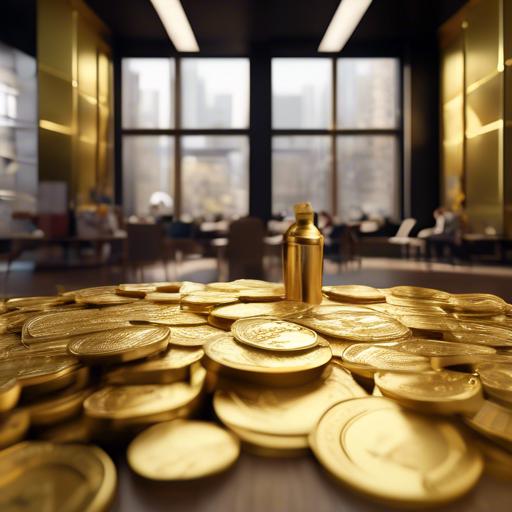Have you ever wondered just how much gold is actually in a gold medal? We’ve got the inside scoop on the precious metal content of these coveted awards. Let’s dive into the world of Olympic glory and discover the true value of a gold medal.
What is a Gold Medal really Made Of?
Many people think that a gold medal is made entirely of gold, but the reality might surprise you. In fact, a gold medal is only required to contain a minimum of 6 grams of gold, according to Olympic regulations. This means that moast of the medal is actually made of silver, with only a thin layer of gold plating on top.
So, if you’re wondering how much gold is in a gold medal, the answer is not as much as you might think. The precious metal content is minimal compared to the overall weight of the medal. Despite this, the symbolism and prestige associated with winning a gold medal remain as strong as ever, regardless of the actual composition of the medal itself.
The Composition of Olympic Gold Medals Revealed
Ever wondered how much gold is actually in an olympic gold medal? The answer might surprise you! While the name implies that the medal is made entirely of gold, the truth is that it’s actually mostly composed of silver. In fact,Olympic gold medals are required to be made up of at least 92.5% silver, with just a thin coating of gold plating on top. The exact amount of gold used can vary depending on the year and host country, but it’s usually less than 1% of the total weight.
So, what about the rest of the composition? In addition to the silver core and gold plating, Olympic gold medals also contain a small amount of copper. This combination of metals gives the medals their distinctive shine and durability. while they may not be solid gold, Olympic gold medals are still a highly coveted prize that symbolizes excellence and achievement in the world of sports.
How Much Pure Gold is in an Olympic Gold Medal?
Ever wondered how much pure gold is actually in an Olympic gold medal? While the name may suggest that the medal is made entirely of gold, the truth is a bit different. Here’s a breakdown of the composition of an Olympic gold medal:
The gold medals awarded at the olympics are not made entirely of gold. In fact,they are made up of mostly silver,with a thin layer of gold plating. The international Olympic Committee requires that the gold medals must contain at least 92.5% silver and a minimum of 6 grams of gold. The rest of the medal is made up of copper. So, while the gold medal is a symbol of victory and achievement, it’s not quite as pure gold as you might think!
Tips for Ensuring the Authenticity of a Gold Medal
When it comes to the authenticity of a gold medal, there are a few tips to keep in mind to ensure that you are getting the real deal. One important factor to consider is the actual gold content of the medal. While most gold medals are not made entirely of gold, they do contain a certain percentage of the precious metal. To determine the gold content of a medal,look for markings or engravings that indicate the purity of the gold. These markings typically include numbers such as 14K, 18K, or 24K, with 24K being the purest form of gold.
Another tip for ensuring the authenticity of a gold medal is to carefully examine the weight of the medal. Gold is a dense metal, so a genuine gold medal will have a important weight to it. If the medal feels light or flimsy, it may not be made of real gold. Additionally, consider taking the medal to a professional appraiser or jeweler to have it tested for authenticity. These experts have the tools and knowledge to determine whether a gold medal is real or counterfeit.
Q&A
Q: How much gold is actually in an Olympic gold medal?
A: Despite its name, an Olympic gold medal is not entirely made of gold. In fact, it is mostly composed of silver and only contains a small amount of gold plating.
Q: So, how much gold is in a gold medal?
A: The gold medal awarded at the Olympics is required to contain a minimum of 6 grams of gold plating. Tho, the majority of the medal is made up of silver, with only a thin layer of gold on the surface.
Q: Why is there so little actual gold in a gold medal?
A: The small amount of gold in a gold medal is primarily for symbolic purposes. The International Olympic Committee began using gold-plated medals in 1912 due to the high cost of solid gold medals.
Q: Are there any other materials used in Olympic medals?
A: In addition to gold and silver,Olympic medals also contain traces of copper. This combination of metals gives the medals their distinctive appearance and durability.
Q: Do athletes actually receive a gold medal worth its weight in gold?
A: Sadly, the value of an Olympic gold medal in terms of its gold content is relatively low. The true value of the medal lies in the achievement and recognition it represents for the athlete.
Final Thoughts
Well, there you have it folks – the surprising truth about how much gold is actually in a gold medal. Turns out, it’s not all glitter and shine! But hey, whether it’s pure gold or just a thin layer, those Olympic champions are still out there proving their mettle. so next time you see those athletes standing proud on the podium, just remember – there may not be as much gold as you think, but the glory is still all theirs. Stay tuned for more intriguing insights into the world of sports and beyond. Thanks for reading!


